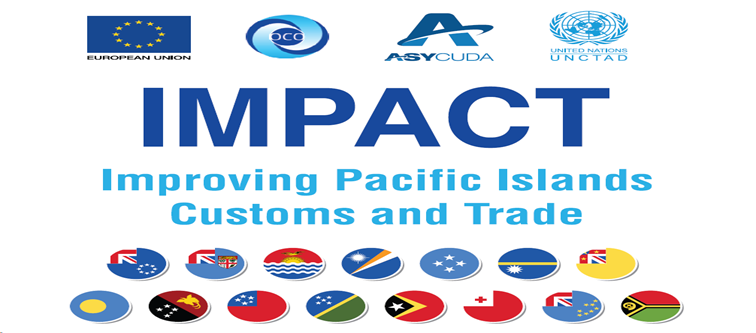
BACKGROUND:
Under the IMPROVING PACIFIC ISLANDS CUSTOMS AND TRADE (IMPACT) project, the EU together with UNCTAD, and OCO have teamed up to undertake a GAP Analysis exercise, in which the implementation rate of the 15 Pacific countries of the African, Caribbean and Pacific States (PACP) on customs related measures of the World Trade Organisation Trade Facilitation Agreement (WTO TFA), the Revised Kyoto Convention (RKC) and the Interim Economic Partnership Agreement (iEPA) are measured.
PROJECT OBJECTIVES
The IMPACT project pursues several core objectives to enhance regional and international trade in the Pacific region:
Supporting Trade Facilitation: The project seeks to enable Pacific countries to harness the benefits offered by the WTO TFA.
• Streamlining Customs Operations: Efforts are directed towards standardizing and simplifying customs procedures, ensuring efficiency and consistency in operations.
• Promoting Single Window Systems: The initiative aims to facilitate the development of Single Window systems, promoting a unified platform for streamlined trade-related processes.
• Building Capacities: The project focuses on strengthening the capacities of PACP member countries, empowering them with the necessary skills and knowledge to engage effectively in international trade.
GAP ANALYSIS METHODOLOGY
The Gap Analysis exercise is structured into three distinct phases:
Phase 1 – Desk Review: An initial comprehensive review of relevant documents and materials to establish a baseline understanding of the existing customs practices and their alignment with international agreements.
Phase 2 – Online Survey: A detailed online survey, a vital component of the analysis, aimed at gathering specific data and insights from the 15 Pacific countries regarding their implementation progress and challenges faced in adhering to the WTO TFA, RKC, and iEPA.
Phase 3 – Country Site Validation: In this phase, the findings from the desk review and online survey are validated through on-site visits and interactions during country missions, ensuring the accuracy and reliability of the gathered information.
ONLINE SURVEY
Within the framework of the IMPROVING PACIFIC ISLANDS CUSTOMS AND TRADE (IMPACT) project, a collaborative effort between the European Union (EU), UNCTAD, and Oceania Customs Organisation (OCO) is underway. This initiative aims to conduct a comprehensive analysis of the implementation progress of the 15 Pacific countries belonging to the PACP countries regarding customs-related measures outlined in key international agreements: the WTO TFA, the RKC, and the iEPA.
[1] Cook Islands, Fiji, Kiribati, Marshall Islands, Federated States of Micronesia, Nauru, Niue, Palau, Papua New Guinea, Samoa, Solomon Islands, Timor-Leste, Tonga, Tuvalu, and Vanuatu